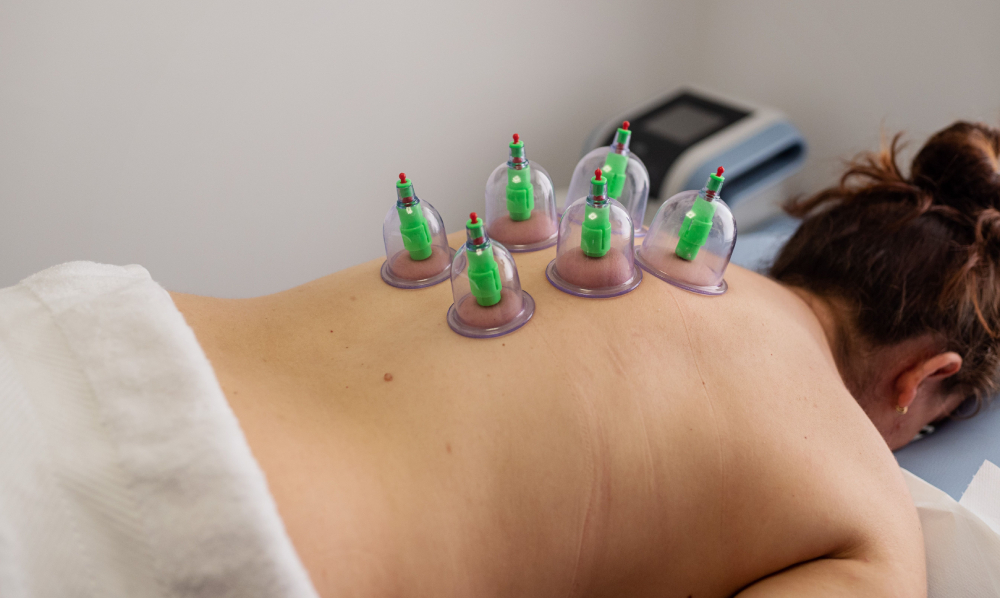What Is Cupping Therapy?
Cupping therapy, an age-old alternative medicine, has been practiced in various cultures for centuries. Despite its historical roots, it has gained a modern resurgence, particularly noted among athletes and celebrities. This therapy is distinctive for the circular bruises it leaves, a visual hallmark of its healing process. Here’s a more detailed look into what cupping therapy entails:
1. Historical Background
- Ancient Practices: The origins of cupping therapy can be traced back to ancient Egyptian, Chinese, and Middle Eastern cultures. It is mentioned in one of the oldest medical textbooks, the Ebers Papyrus, which dates back to 1,550 B.C.
- Cultural Integration: Over the centuries, various cultures have integrated cupping into their healing practices, each adding their unique touch to the method.
2. Variations of Cupping
- Dry Cupping: This traditional method involves a therapist placing heated cups on the skin to create a vacuum, leading to suction.
- Wet Cupping: A more intensive version, combining suction with medicinal bleeding.
- Moving Cupping: Apply oil on the skin before moving the cups over different areas.
- Modern Adaptations: Use rubber pumps instead of heat to create suction and silicone cups for more effortless movement on the skin.
3. The Procedure Explained
- Preparation: The therapist heats cups using a fire or a rubber pump.
- Application: Cups are placed on the skin, creating suction that draws the skin up.
- Duration: Cups are generally placed for 5–20 minutes.
- Post-Procedure: Skin is often treated with massage or ointments to relieve discomfort.
4. Therapeutic Benefits
- Muscle Relaxation: Helps in loosening tight muscles and easing stiffness.
- Enhanced Circulation: Increases blood flow to the area, promoting healing.
- Detoxification: Believed to help draw out toxins from the body.
- Immune Boosting: Some practitioners claim it helps boost immune function.
5. Potential Risks and Side Effects
- Bruising: The most common side effect, usually harmless and temporary.
- Mild Discomfort: Some may experience minor pain during the procedure.
- Risk of Burns: Especially in traditional fire cupping methods.
- Infection Risk: If the equipment is not sterilized properly.
6. Contraindications
- Blood Disorders: Such as hemophilia or those taking blood thinners.
- Severe Skin Conditions: Including ulcers, psoriasis, or severe eczema.
- Other Conditions: Such as heart disease or kidney failure.
7. Finding the Right Practitioner
- Certification and Experience: It is essential to check the practitioner’s qualifications.
- Personalization: Therapists should tailor the treatment to individual needs.
- BestAcupuncturistOC.com: Offers a platform to find licensed and experienced therapists in cupping therapy, with detailed profiles, qualifications, and user reviews.
8. Conclusion
With its rich history and various techniques, Cupping therapy offers a unique pain relief and healing approach. The importance of consulting with a certified practitioner cannot be overstated, as it ensures a safe and beneficial experience. Platforms like BestAcupuncturistOC.com provide a valuable resource for connecting with qualified cupping therapists.
This detailed analysis offers a deeper understanding of cupping therapy, covering its history, techniques, benefits, risks, and how to engage with this practice safely. It highlights the role of platforms like BestAcupuncturistOC.com in facilitating access to qualified professionals.
Conditions Treated
- Pain Conditions: Musculoskeletal Pain (back, neck, knee, shoulder, elbow, etc.), Arthritis, Migraines, Headaches, Sports Injuries, Fibromyalgia, TMJ, Post-Operative Recovery, Nervous System Disorders.
- Respiratory Disorders: Asthma, Allergies, Sinus Problems.
- Gastrointestinal Disorders: Irritable Bowel Syndrome, Food Allergies, Ulcers, Gastritis, Acid Reflux, Indigestion, Constipation/Diarrhea.
- Women’s Health: Infertility, PMS, Menstrual Irregularities, Endometriosis, Polycystic Ovarian Syndrome, Menopause, Hormonal Imbalances, Pregnancy Conditions, Postpartum, Reproductive Disorders, Breech Baby.
- Men’s Health: Incontinence, Reproductive Disorders, Prostate Problems.
- Children’s Health: Coughs, Colic, Allergies, ADD/ADHD, Sleep Disorders, Digestive Problems, Fever/Flu/Colds, Stomach Aches/Nausea, Headaches, Bed Wetting.
- Addictions: Smoking, Cravings, Drugs, Alcohol.
- Mental/Emotional: Depression, Anxiety, Insomnia, Sleep Disturbances, Stress.


